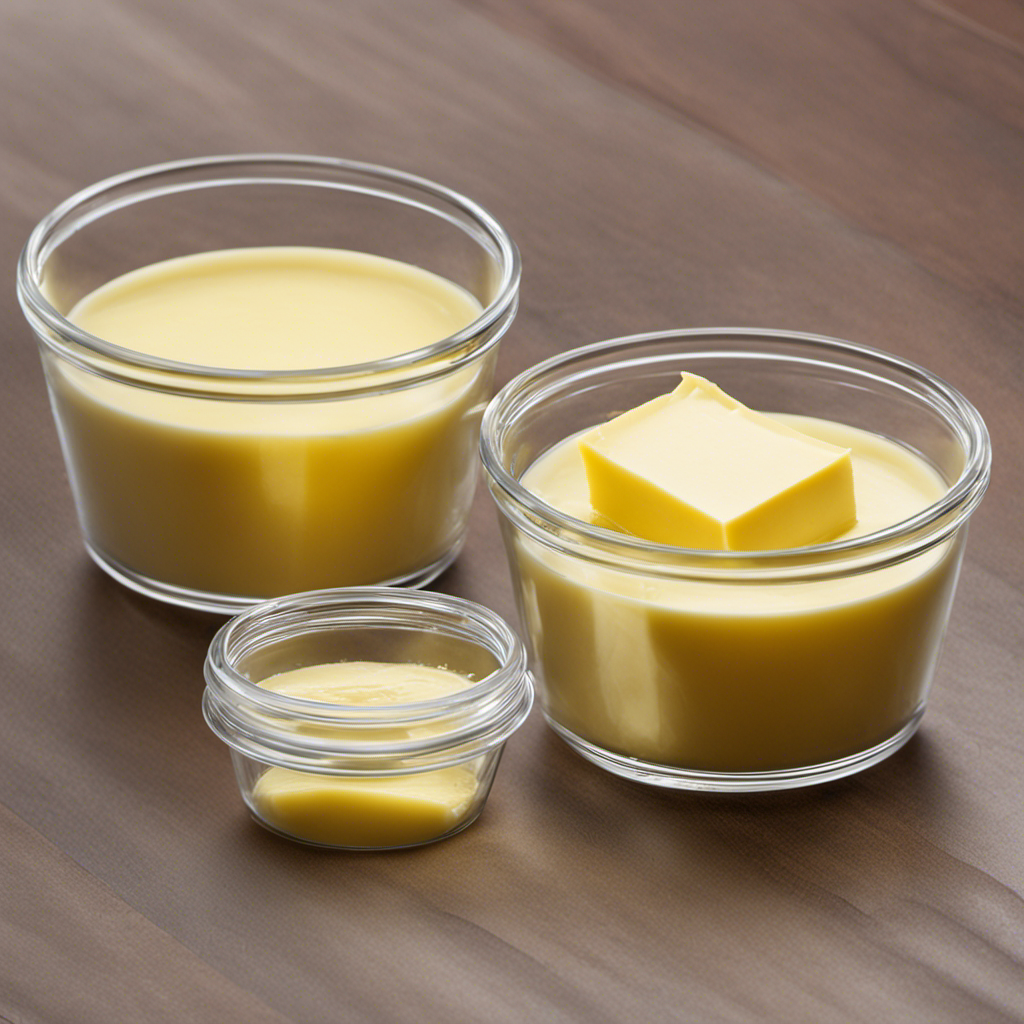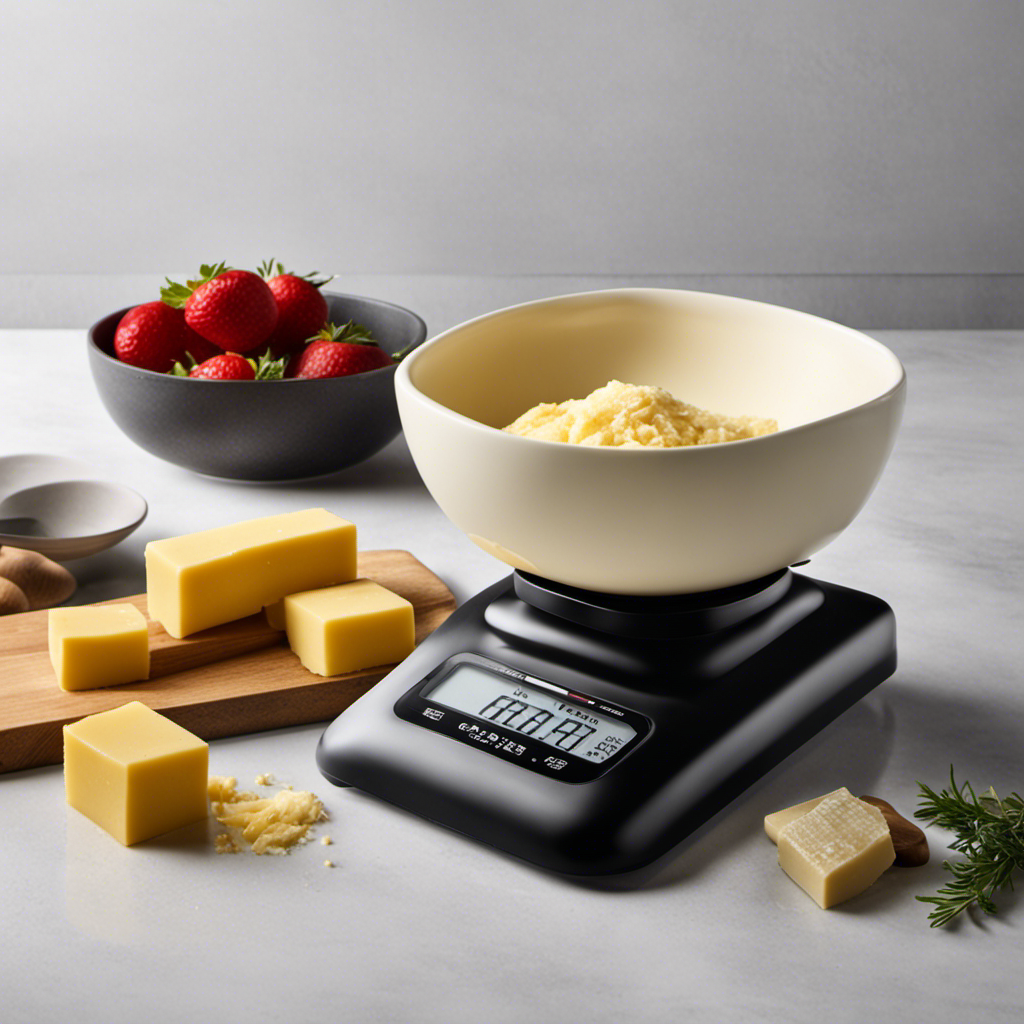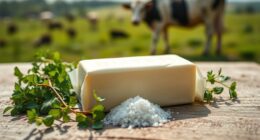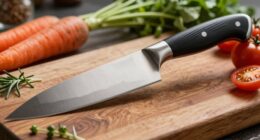Did you realize that lima beans and butter beans are two well-liked legumes that have distinct characteristics? In this article, I will delve into the origins, appearance, taste, texture, nutritional value, culinary uses, cooking time, availability, and substitutes for these two types of beans.
By understanding the distinctions between lima beans and butter beans, you’ll be better equipped to choose the right one for your recipes and enjoy their unique flavors and textures.
So, let’s dive in and unravel the mystery behind these delicious legumes.
Key Takeaways
- Lima beans originated in Central America and were widely consumed by Native American tribes, while butter beans originated in South America and were cultivated by ancient civilizations like the Incas and Mayans.
- Lima beans are small, flat, and green with a smooth texture and slightly wrinkled skin, while butter beans are larger, plump, and creamy white with a velvety texture and smooth skin.
- Lima beans have a slightly nutty flavor and subtle sweetness, while butter beans have a creamy and buttery taste that is milder in sweetness.
- Lima beans are high in fiber, protein, iron, and potassium, while butter beans are a great source of complex carbohydrates, vitamins, and minerals. Both beans offer health benefits and can be cooked in various ways.
Origins
Did you know that butter beans are believed to have originated in South America, while lima beans are thought to have originated in Central America? Both beans have different origins, but they share a common cultural significance.
Butter beans, also known as Lima beans in some regions, have been cultivated for thousands of years. They were an important staple in the diets of ancient civilizations, such as the Incas and Mayans. In South America, butter beans were considered a sacred crop and were often used in religious ceremonies.
On the other hand, lima beans were widely consumed by Native American tribes in Central America and were a valuable source of nutrition.
Today, both beans are popular ingredients in various cuisines around the world, contributing to their cultural significance.
Appearance
Lima beans and butter beans have distinct appearances. Lima beans are small, flat, and green in color. They have a smooth texture and a slightly wrinkled skin. On the other hand, butter beans are larger, plump, and creamy white in color. They have a velvety texture and a smooth skin. To better understand the differences between these two beans, let’s take a closer look at their appearance:
| Beans | Color | Size |
|---|---|---|
| Lima beans | Green | Small |
| Butter beans | White | Large |
As we can see, the color and size are the key distinguishing factors between lima beans and butter beans. Now that we have explored their appearances, let’s move on to the next section to discuss their taste.
Taste
When you take a bite, you’ll notice that lima beans have a slightly nutty flavor, while butter beans have a creamy and buttery taste. Both beans are known for their unique flavors that can complement a variety of dishes.
Lima beans tend to have a subtle sweetness level, while butter beans are milder in sweetness. In terms of cooking methods, lima beans are often boiled or steamed until tender, while butter beans are commonly used in stews, soups, and casseroles.
Both beans are versatile and can be used in a variety of recipes, adding texture and flavor. Whether you prefer the nuttiness of lima beans or the creaminess of butter beans, they are both delicious additions to any meal.
Texture
As you take a bite of these beans, you’ll feel the contrasting textures, with lima beans being slightly firm and butter beans having a smoother consistency. The texture of lima beans is often described as tender yet slightly starchy, while butter beans are known for their creamy and velvety texture. Both beans are versatile in cooking techniques and can be used in various recipes. Lima beans hold their shape well, making them suitable for soups, stews, and salads. On the other hand, butter beans are often used in purees, dips, and casseroles due to their smooth texture. Whether you prefer a firmer bite or a creamy mouthfeel, both lima beans and butter beans offer unique textures that can elevate your dishes.
| Lima Beans | Butter Beans | |
|---|---|---|
| Texture | Slightly firm | Smoother consistency |
| Cooking Techniques | Soups, stews, salads | Purees, dips, casseroles |
| Recipe Ideas | Lima bean soup, Mediterranean salad | Butter bean hummus, creamy butter bean casserole |
Nutritional Value
Both lima beans and butter beans offer a range of nutritional benefits.
Lima beans are high in fiber, which aids in digestion and helps maintain a healthy weight. They are also rich in protein, iron, and potassium, which promote muscle growth, oxygen transport, and heart health.
Butter beans, on the other hand, are a great source of complex carbohydrates, providing sustained energy throughout the day. They are also packed with vitamins and minerals like vitamin C, vitamin K, and folate, which support immune function, bone health, and fetal development.
When it comes to cooking benefits, both beans can be prepared in various ways, such as boiling, steaming, or adding them to soups and stews.
Overall, incorporating lima beans and butter beans into your diet can provide numerous health benefits and add variety to your meals.
Culinary Uses
When it comes to culinary uses, flavor profiles and cooking methods are crucial to consider. Understanding the flavor profiles of different ingredients allows us to create well-balanced and harmonious dishes.
Additionally, knowing the appropriate cooking methods for each ingredient ensures that we achieve the desired texture and taste.
In this discussion, we will delve into the flavor profiles and cooking methods of various ingredients, providing insights on how to elevate our culinary creations.
Flavor Profiles
If you’re looking for a milder taste, butter beans might be the better choice over lima beans. While both beans belong to the same family, their flavor profiles differ.
Lima beans have a distinct taste that is slightly sweet and nutty. On the other hand, butter beans have a more delicate and buttery flavor. The difference in taste can be attributed to the levels of natural sugars present in each bean.
When it comes to cooking techniques, both beans can be used in various dishes. Lima beans are commonly used in soups, stews, and casseroles, while butter beans are often enjoyed in salads and as a side dish.
Ultimately, your preference for sweet or savory flavors will determine which bean is the best fit for your culinary needs.
Cooking Methods
To enhance the flavor of your dish, try experimenting with different cooking methods for butter beans and lima beans.
Both beans can be boiled, steamed, or sautéed, but each method brings out unique qualities in the beans.
Boiling is a simple and straightforward way to cook beans, but it can sometimes result in a slightly mushy texture.
Steaming the beans helps to retain their shape and texture while adding a subtle nutty flavor.
Sautéing, on the other hand, brings out a rich and buttery taste in the beans.
Whether you choose to boil, steam, or sauté your butter beans or lima beans, you can easily incorporate them into alternative recipes such as soups, stews, and salads.
Additionally, both beans offer various health benefits, including being a good source of fiber, protein, and essential vitamins and minerals.
Cooking Time
The cooking time for lima beans is usually shorter than that of butter beans. Lima beans typically take around 15-20 minutes to cook, while butter beans can take up to 30-45 minutes. However, the cooking time can vary depending on the size and freshness of the beans.
To save time during cooking, there are a few alternative cooking techniques you can try. One option is to use a pressure cooker, which can significantly reduce the cooking time. Another tip is to soak the beans overnight before cooking, as this can help to soften them and reduce the cooking time. Additionally, you can cut the beans into smaller pieces, which will also decrease the cooking time.
These time-saving tips can be useful when preparing lima or butter beans.
Availability
Seasonal and regional availability are important factors to consider when it comes to the availability of certain foods.
Seasonal availability refers to the time of year when a particular food is at its peak and readily found in abundance.
Regional availability, on the other hand, refers to the specific geographic areas where a certain food is commonly grown or produced.
Understanding these two factors can help consumers make informed choices about what fruits, vegetables, and other foods are likely to be freshest and most readily available in their area at any given time.
Seasonal Availability
You can find lima beans and butter beans in different seasons. Eating seasonal produce has many benefits, such as better flavor and higher nutritional value. When it comes to meal planning, the seasonal availability of lima beans and butter beans can impact the variety and diversity of our meals.
During the summer months, fresh lima beans are readily available, making them a delicious addition to salads and vegetable dishes. On the other hand, butter beans are typically available in the spring and fall. Their creamy texture and mild flavor make them perfect for soups and stews.
Regional Availability
Regional availability affects the access and variety of beans we can find in different areas. Here are four key factors that highlight the impact of regional availability on beans:
-
Cultural significance: Different regions have their own culinary traditions and preferences, which directly influence the types of beans that are commonly consumed. For example, black beans are a staple in Latin American cuisine, while kidney beans are popular in Indian and Middle Eastern dishes.
-
Environmental impact: Beans are grown in specific regions based on climate, soil conditions, and water availability. The environmental conditions of a region determine which types of beans can be cultivated successfully. For instance, certain varieties of beans thrive in humid tropical climates, while others grow best in arid regions.
-
Local sourcing: Regional availability allows for the sourcing of beans from nearby farms, reducing transportation costs and carbon emissions associated with long-distance transportation. This supports local economies and promotes sustainability.
-
Seasonal variations: Beans are subject to seasonal fluctuations in availability. Some regions may have abundant supplies of certain beans during specific times of the year, while others may experience scarcity. This influences the variety of beans that are accessible to consumers in different regions.
Regional availability plays a crucial role in determining the range of beans that we can find and enjoy in different areas. It reflects cultural preferences, environmental factors, local sourcing practices, and seasonal variations, all of which contribute to the diversity and availability of beans worldwide.
Substitutes
If you’re looking for a substitute for lima beans or butter beans, try using navy beans instead. Navy beans are small, oval-shaped beans that are creamy white in color. They are a nutritious choice and offer several health benefits.
Navy beans are a good source of fiber, protein, and essential nutrients like iron, magnesium, and folate. They can help promote digestive health, regulate blood sugar levels, and support weight management.
In terms of recipe ideas, navy beans can be used in a variety of dishes. They are commonly added to soups, stews, and chili, providing a creamy texture and mild flavor. They can also be mashed and used as a base for dips or spreads.
Frequently Asked Questions
Can Lima Beans and Butter Beans Be Used Interchangeably in Recipes?
Yes, they can be used interchangeably in dishes. However, there are some nutritional differences between lima beans and butter beans.
Are Lima Beans and Butter Beans the Same Thing?
Lima beans and butter beans are not the same thing. They have differences in taste and nutritional value. Lima beans are creamier and nuttier, while butter beans have a milder flavor. Nutritionally, they are similar but may vary slightly in protein and fiber content.
Can Lima Beans and Butter Beans Cause Any Allergic Reactions?
Lima beans and butter beans can potentially cause allergic reactions. However, they also offer various health benefits, such as being high in fiber and protein, and may help lower cholesterol levels.
Can Lima Beans and Butter Beans Be Eaten Raw?
Yes, lima beans and butter beans can be eaten raw, but it is recommended to cook them to eliminate any potential toxins. Cooking also enhances their nutritional value and makes them easier to digest.
Are Lima Beans and Butter Beans High in Carbohydrates?
Lima beans and butter beans are both high in carbohydrates, making them a great source of energy. Incorporating these beans into a balanced diet can provide nutritional benefits like fiber, protein, and essential vitamins.
Conclusion
After diving into the world of legumes, it’s clear that while lima beans and butter beans may share a common ancestry, they are distinct in their own right.
From their origins to their appearance, taste, texture, and nutritional value, these beans showcase unique qualities.
Whether you’re a culinary enthusiast or simply looking for a new addition to your pantry, understanding the differences between lima beans and butter beans will help you make informed choices.
So go ahead, let these legumes dance their way into your next delicious dish!









